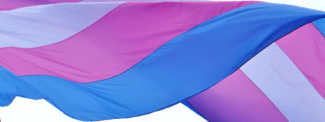by Jennifer Benner, MPP, Resource Development Specialist at the National Sexual Violence Resource Center
Transgender: “An umbrella term that encompasses a wide range of people whose gender identity or expression may not match the sex they were assigned at birth” (FORGE, 2012).
Transgender is not a sexual orientation, as trans-identified people may identify as straight, gay, lesbian, bisexual, etc. (Human Rights Campaign, n.d.). In this post we will use the language of trans, transgender, gender nonconforming, and gender non-binary interchangeably to reflect how individuals self-identify with regard to gender. We honor and recognize the complexity and multiplicity of gender identities and that not everyone identifies as male or female or uses other language to describe themselves. These words are used in their broadest meanings in an attempt to be inclusive of all identities.
Let’s move past definitions and labels for the people we serve to the more important topic of meeting the needs of all individuals we serve. As advocates working in the sexual violence prevention and intervention field, we know that all forms of oppression are linked (racism, classism, ableism, sexism, etc.). This is why it is important for service providers to understand the issues that intersect and have a huge impact on what survivors of sexual violence face in order to help them in their journey. Transgender people experience sexual violence at a higher rate and often face barriers in accessing rape crisis services because of organizational practices and policies that make it difficult for trans, transgender, gender non-conforming, and gender non-binary survivors of sexual assault to access services or receive equal treatment. Those survivors who are also low income, non U.S. citizens, or engaged in sex work are even more at risk to receive unequal treatment (Seelman, 2015). Below are some tips and resources on how to support trans, transgender, gender nonconforming and gender non-binary survivors of sexual assault.
1. Check yourself.
When a transgender or gender non-conforming survivor comes in for services, take a breath and listen, be nonjudgmental, and most importantly believe the survivor. Use person first language and use appropriate pronouns, ask the survivor their preferred name and pronoun. Empower the survivor and let the process be survivor led with focus on their primary concerns and goals. Sexual violence leaves people feeling disempowered and removed from their community. Some of this work should be done prior to seeing a transgender survivor. For example, build relationships with other programs that serve trans communities to help provide additional services. Ensure a welcoming environment that is trauma informed, for example have materials that reflect the trans community, provide a gender inclusive bathroom, provide resources for those in this community in the waiting room.
2. Get educated.
Take the time to learn about trans survivors and the issues they face before a transgender client comes in for services. Below are some statistics:
- Over half of all transgender people have experienced sexual victimization at some point in their lives (Clements-Noelle, Marx, & Katz, 2006; Kenagy, 2005).
- In one study 76% of transgender students said they experienced sexual harassment at school and 54% who were harassed or assaulted did not report it to teachers or staff (Greytak, Kosciw, & Diaz 2009).
- School bathrooms and locker rooms are unsafe for transgender students. In the 2013 National School Climate Survey, transgender students were more likely than all other students to avoid gender segregated spaces. Over 60% of transgender students reported avoiding school bathrooms and over 50% avoided locker rooms because of fear (Kosciw, Greytak, Palmer, & Boesen, 2014).
- Transgender veterans are almost three times more likely to report experiencing military sexual trauma than non-transgender veterans (Brown & Jones, 2016).
- Transgender individuals face employment discrimination and economic insecurity which puts them at even greater risk for victimization. They face double the rate of unemployment as compared to the general population and are 90% more likely to experience harassment, mistreatment or discrimination (Grant et al., 2011).
- Almost 20% report homelessness at some point of their lives because they were transgender, 22% trying to seek access to a homeless shelter were sexually assaulted by staff or residents (Grant et al., 2011)
3. Explore resources.
For more information on how to support trans, transgender, gender nonconforming, and gender non-binary survivors of sexual assault check out the following resources* from FORGE:
- Practical Tips for Working With Transgender Survivors of Sexual Violence
- First Do No Harm: 8 Tips for Addressing Violence Against Transgender and Gender Non-Binary People
- Resources for Providers Serving Transgender Survivors
- Transgender Sexual Violence Survivors: A Self-Help Guide to Healing and Understanding
Useful agencies and organizations that provide support and advocacy to the LGBTQ communities:
- FORGE supports, educates, and advocates for the rights of transgender individuals, provides information and resources.
- Anti Violence Project provides information and resources including a 24 hour hotline for LGBTQ and HIV affected victims and survivors of any type of violence.
- Human Rights Campaign provides information and resources on policies that impact LGBT communities.
- National Center for Transgender Equality (NCTE) focuses on policy change to advance transgender equality. They provide information and resources, including know your rights section.
- National LGBTQ Task Force provides, training and resources on LGBTQ issues.
- Services and Advocacy for Gay, Lesbian, Bisexual, & Transgender Elders (SAGE) advocates on behalf of LGBT older adults, provides information and resources.
Suicide Prevention:
- The Trevor Project provides free and confidential phone, instant message and text messaging crisis intervention services for LGBTQ young people.
Trans Lifeline is a crisis line for transgender people.
Legal Resources:
- Southern Poverty Law Center (SPLC) provides information, resources on legal issues.
- Transgender Law Center provides information and resources, and a Legal Information Helpline.
For information on how to obtain any resources please contact the NSVRC library.
* Readers may also be interested in the related NRCDV TA Guidance document, Sheltering Transgender Women: Providing Welcoming Services by Michael munson of FORGE (September 2014).














